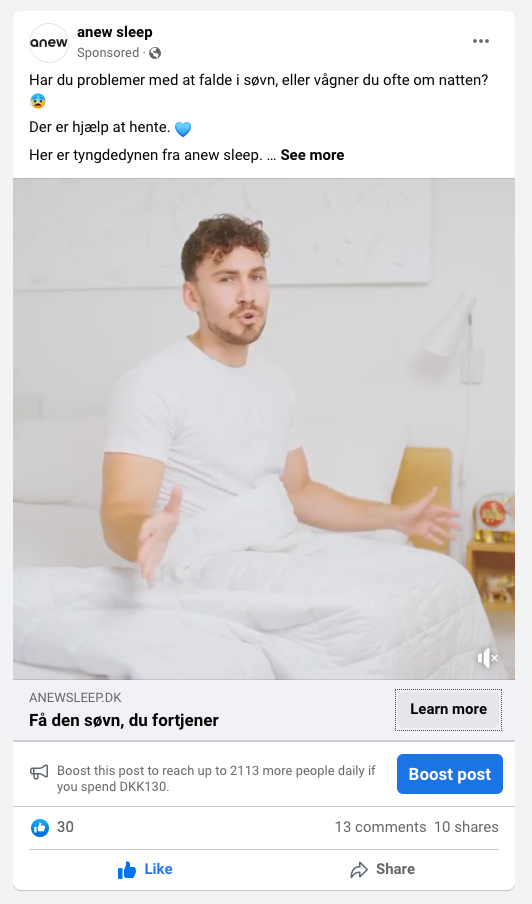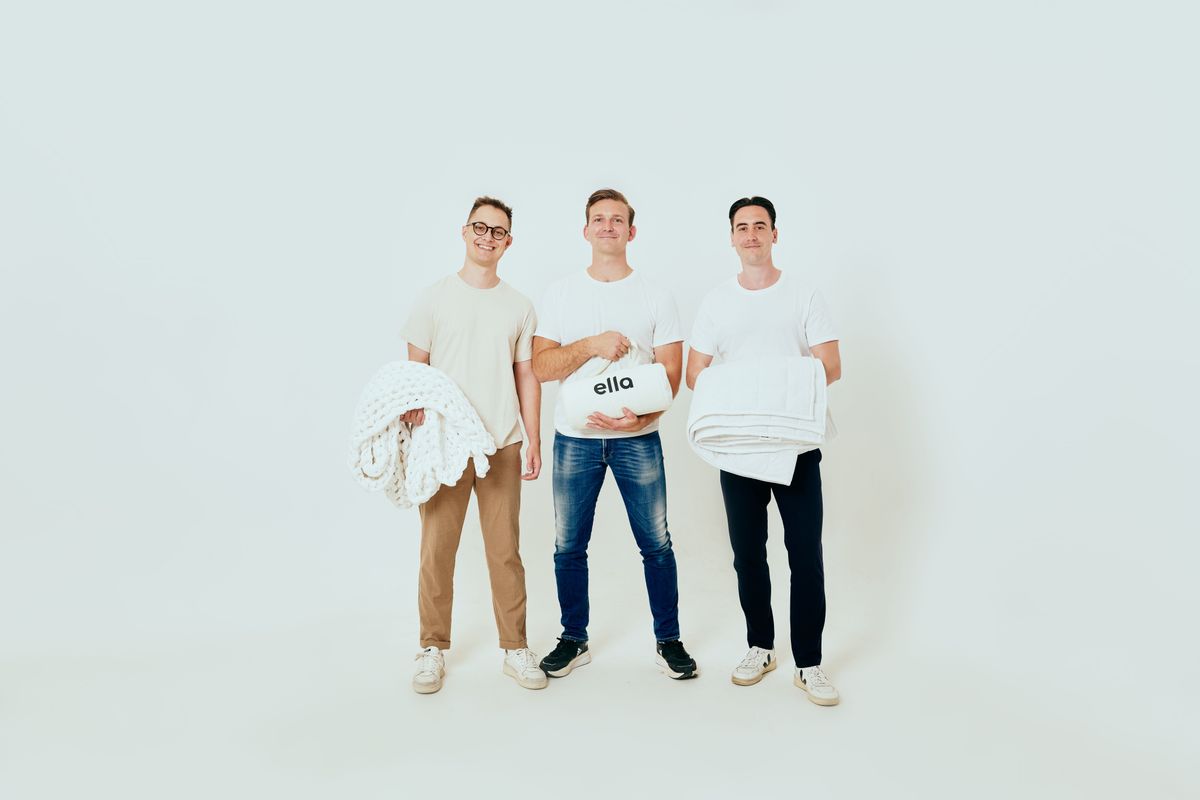Anew sleep was officially established on February 22, 2022, but due to delays in our deliveries, we could only open the webshop at the end of September and start selling there.
Many have been curious about how we spent the time from February 22, 2022, to September 19, 2022 (soft launch date for friends and acquaintances). After all, we were three people working full-time in a basement office in Copenhagen for over half a year. We'll save that story for another time 😄
For me, the last three months (October, November, and December in 2022) have been particularly fun. During this time, we needed to answer questions like:
- Who is our target audience?
- How do we do marketing best?
- What does it cost to acquire a new customer?
- And can we succeed in selling weighted blankets to the Danes?
These were the months where we had to crack the code for various channels and figure out how to make the most out of them.
I have tried to jot down some thoughts. Here they are.
Slow is smooth, smooth is fast
During my time at PL & Partners, I distinctly remember that it always required great patience when starting a new client from scratch. You never know how long it can take to solve a case; it can take weeks, even months, and some clients you couldn't get to where they wanted.
In anew sleep, we had set an ambitious goal, where we were to reach a turnover of more than 1,000,000 DKK excl. VAT over the first five months. The time horizon of five months was shortened as our launch was postponed. In the end, we only had three months to reach the ambitious budget of 1,000,000 DKK excl. VAT.
Therefore, it was important that we found one or more ways to generate revenue and were ready to quickly increase the marketing budget.
We started with 1,000 DKK per day: 500 DKK on Facebook and 500 DKK on Google Ads.
It became 2,000 DKK.
3,000 DKK
5,000 DKK.
And then it increased.
During our peak period (within the three months), we profitably spent over 13,500 DKK per day on digital marketing (note: not during Black Friday and Cyber Monday - it was higher then).
And daily we have had marketing up for discussion:
Are we over- or underspending budget on paid ads?
And is our budget allocated correctly across the right channels?
To answer these questions, we used Zero Party Data and Reaktion.com. And then we analyzed every single touchpoint on all orders.
It was important to take things calmly and in a controlled matter: not to make drastic decisions (without data). By ensuring that the foundation is in place and that we know our business and customers better, we have been able to manage our marketing more effectively and ensure a steady flow of new customers.
Data-driven marketing decisions
I have always enjoyed using data. It played a central role in our start-up of PL & Partners and has been crucial for the results we have achieved for our clients. Therefore, a data-driven approach to anew sleep has also been a major focus. We needed to use all the right tools.
But our business decisions should always be based on data.
So, it was good timing when shortly after my first post on LinkedIn, I received a message in my inbox:
Hi Kristian,
It sounds like an exciting new journey with Anew Sleep! Cool team you also have on the project. I would very much like to show you Reaktion which can help you with an overall view of your ecommerce business, attribution, profit tracking, and much more. Feel free to reach out if you find it exciting.
Best regards, Mikkel // Reaktion.com
When I had my meeting with Mikkel, I learned that Reaktion needed to be a part of our tool stack in anew sleep. Since then Reaktion has played a central part in our daily decision making around digital marketing.
For us, Reaktion has made it possible to maintain a clear overview of the turnover and profits on a daily basis.
Today, Reaktion is always open in a tab on the computer and mobile. They just need to make an app for iPhones (and widgets for the home screen), then they have everything. 😄
Moreover, we have made use of Zero Party Data, which has provided us unique insight.
Our way of collecting Zero Party Data was by asking customers as soon as they had purchased:
- "Where did you first hear about us?"
- "What made you order with us today?"
This has provided really good insight into what channels are doing well, what customers particularly appreciate, and which major pain points we are solving for the customers.
And these learnings come in handy when creating ads for social media.
Where it all started
Facebook started as a small, irrelevant, and difficult platform to use, but has developed into a preferred marketing channel for many businesses.
I have always been buried in ad accounts, but in recent years at PL & Partners, my area of responsibility has moved further away from the ads manager and more towards strategy, management, and larger projects.
I have therefore been looking forward to returning to my roots and working with Facebook and Instagram advertising again.
Back in September 2022, it started with a 500 DKK daily budget and a handful of video creatives.
I could feel the sensation of being bambi on the ice.
I have several times written "Why can't you do [insert something that I did in 2018] in ads manager?" or "Where is [insert a button]?" to colleagues.
But after a few weeks, the feeling of control and understanding of the platform also returned.
Facebook and Instagram have undoubtedly been one of the channels that have taken the longest properly do well on (performance wise), when I look at the investment in time and money (apart from SEO).
We have changed our approach to content, copywriting, and target groups several times along the way to reach a level of performance that we are satisfied with.
For us, Google Ads were quickest out of the starting blocks, where Meta Ads took about 6 to 7 weeks before we reached a profitable level.
Today, our advertising on Meta drives the largest share of our revenue. We have found a structure and working method that allows us to rely on Facebook and Instagram advertising to create a steady flow of new customers - profitably.
This setup will also be used when we open anew sleep in new countries already in 3-6 months (the plan is to launch Q2 2023.
When it comes to advertising on Meta, there is no discipline more important than being able to create good content. Therefore, you should also know what we have learned here.
Content creation
Another point that has required a lot of our attention has been the creation of content for social media. Now more than ever, it's crucial to have quality content for social platforms. And a lot of it.
We've clearly felt the difference in our approach to creating content for our advertising from late September to now. It began with simple videos, uploaded with srt files, so Meta would add subtitles for us. Here's an example:

This type of content with hardcoded subtitles, very clean design didn't work well for us.
Now began a lengthy process of testing:
- How should we film our videos? iPhone or professional video?
- How long should the videos be? How should we edit them? Talking head or many clips with b-roll?
Throughout this process, we tried various approaches and learned how our ads should look in the top, middle, and bottom funnel. One thing is certain: It's an ongoing process where we need to test many creatives every week. At the time of writing, we have 60 different creatives (in the form of texts and images) that we are testing. Here's an example of what our videos look like today:
This video contains:
- Hook (attention grabber)
Hardcoded subtitles
B-roll to create flow in the video
And a clear call-to-action.
Satellite sites
Before we started anew sleep and decided to enter this market, we conducted thorough research on the market both domestically and abroad. Much indicated that Denmark was late in adopting weighted blankets compared to other nearby markets.
The search volume trends on Google painted a clear picture: 📈
We wanted a significant share of this market.
Our grand ambitions also meant that if we succeeded, we'd invest millions in Facebook advertising over the years, influencing the number of searches on Google for these keywords.
Therefore, it was natural for us to figure out: How can we ensure that as much of the revenue as possible lands with us when people search for weighted blankets?
The answers were:
- Search Engine Optimization
- Owning multiple sites that rank high on Google
So, we launched tyngdedyne.dk and kugledyneinfo.dk - two content universes (satellite sites) about our primary products, aiming to rank high on Google.
I've spoken with many professionals in search engine optimization. They've clearly expressed that it takes double (now triple) the time, money, and energy to rank three domains instead of just one.
I don't disagree. But the potential is greater when you own multiple domains.
We gain clear advantages over competitors:
- More high converting visitors
- Increased revenue
- Larger remarketing audiences.
Especially the last point is beneficial for us. Even though one shouldn't measure the ROI of SEO efforts too soon, we see that it will pay off shortly. Historically, our best rankings have been:
- Tyngdedyne.dk with the 3rd position for "Tyngdedyne" (search volume: 9,900/month)
- Kugledyneinfo.dk with the 4th position for "Kugledyne" (search volume: 5,400/month)
As mentioned earlier, we had 7 months from founding anew sleep to going online and starting sales. During this time, we could focus on our content universes. We could give them a lot of love and energy.
And we're very pleased with that now. But one thing is having good rankings on Google; another is having good products.
Product roadmap
In the beginning, we thought that our existing products (weighted blankets and weighted covers) would suffice for the first 12 months.
However, it quickly became evident that the interest in new products from customers was greater than initially anticipated. Through our suppliers, we also gained access to exciting new products, leading us to now focus on expanding our product range.
At the time of writing, we have three products that we expect to launch within the next 6 months. All three products still fall within the sleep category. I'm looking forward to sharing more about this in the upcoming months.
We're focusing on expanding our product range for several reasons:
- To contribute to a more dynamic brand that encompasses more within the sleep category.
- To increase our AOV (average order value), thereby providing more room in our CAC (customer acquisition cost), allowing us to invest more heavily in marketing.
- To upsell to existing customers and invest more in marketing automation.
What's next?
Currently, we're busy with a variety of tasks, especially focusing on UGC (user-generated content), affiliate marketing, influencers, marketing automation, and more of what works (Meta, Google Ads, and SEO).
I'll be sharing much more about anew sleep, our progress, what we're doing, and specific learnings. If you're curious to follow along, sign up for the newsletter to be notified when new blog posts are available 👋.


